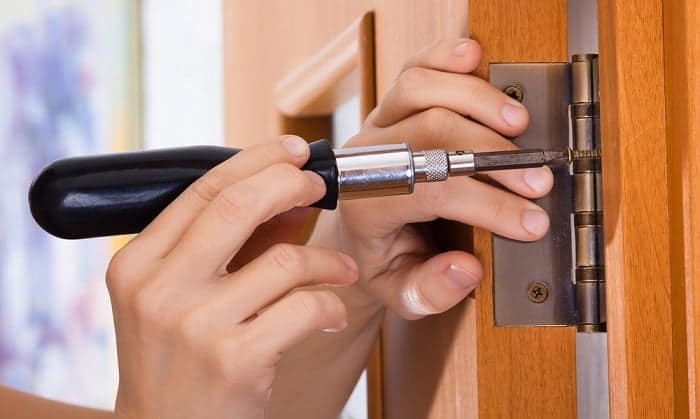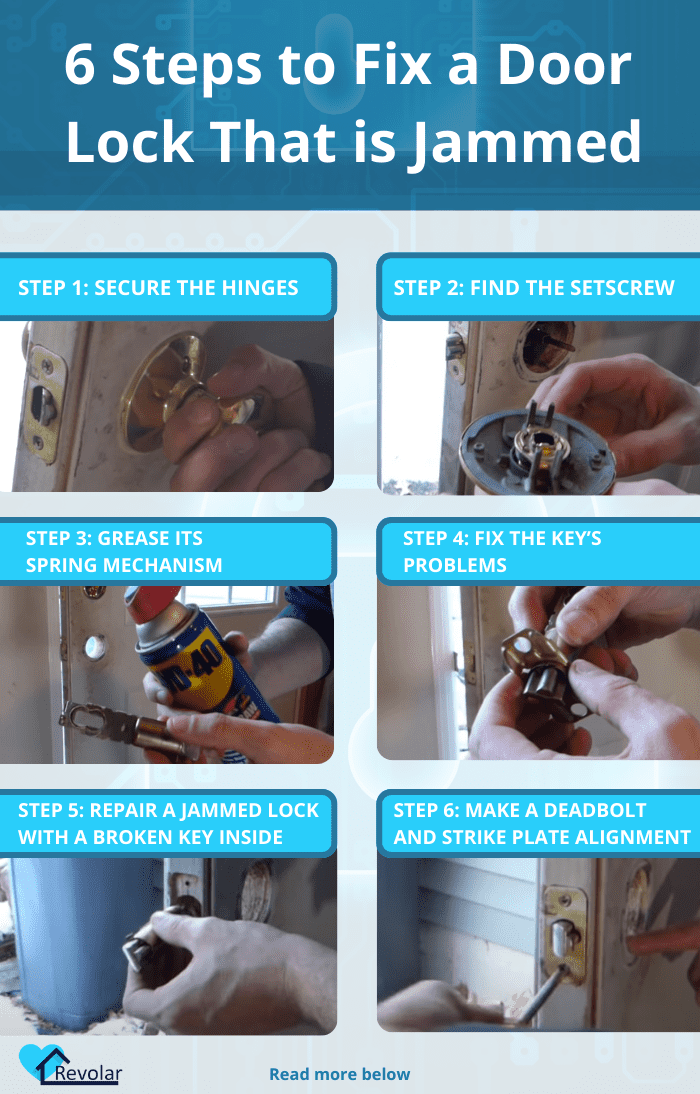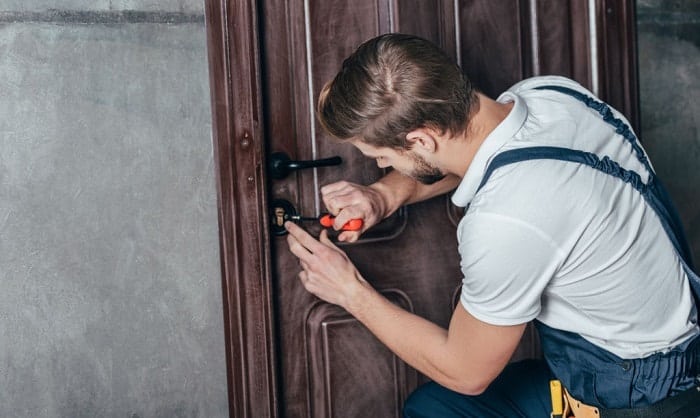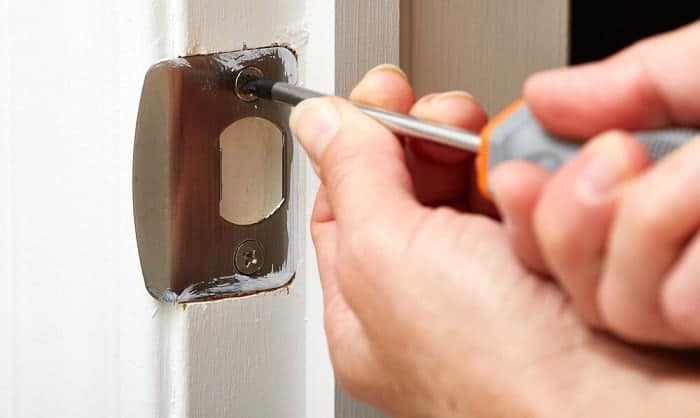There are plenty of reasons that lead to the dysfunction of your locks, such as rust, loose screws, probably a misaligned deadbolt as well. Learning the best way on how to fix a door lock that is jammed depends largely on what causes this jam.
If you have an impression that this might be too complex to proceed with, the truth is not at all. Rest assured that you can easily fix a door knob stuck with some handy materials & installation tools to continue using the door like normal.
Table of Contents
What You Will Need to Follow This Tutorial
To begin with, here are the essential tools and materials you need to prepare to repair any door lock that won’t turn.
Tools: A good screwdriver, preferably a Philips head, a chisel and hammer, a metal file, and a key extractor.
Materials: A lubricant spray, preferably dry; granite.
Here is an overview of the tutorial for fixing a door lock stuck:
- Secure the hinges
- Secure the screw
- Grease its spring mechanism
- Fix the key’s problems
- Repair a jammed lock with a broken key inside
- Make a deadbolt and strike plate alignment
How to Fix a Door Lock That is Jammed Step By Step Instructions
Without further ado, we would like to provide you with the step by step instructions to return a door lock stuck in locked position to its normal condition.
Step 1: Secure the hinges
In case the hinges on your door are loosened, the latch’s position will be lower than that of the strike plate. This causes difficulties in operating the lock.
- Your door and its frame may have a gap in between. The hinges may be loose if your door appears to be slanted.
- Make your hinges visible by opening your door. Take out the Phillips head screwdriver for loose screw tightening. It will lift your door high enough so its deadbolt can return to the locked position in the striker plate.
Step 2: Secure the setscrew
If you can spin the knob but your door does not open, it is likely because a set screw got loosen. This screw holds your knob to its spindle, which makes the connection between the exterior and interior knob.
The following steps will repair a door knob that turns but does not open:
- Find the setscrew. You may find visible set screws on some locks, often on the underside or the neck of this knob. If no screw is located this way, you will need to remove the knob’s faceplate to get access to the screws below.
- Tighten these loose screws with a suitable screwdriver. You can make them spin more easily by applying a lubricant spray.
Step 3: Grease its spring mechanism
When you try to turn the knob, you might find its deadbolt not fully retracting. This is when the spring mechanism inside the lock may be dysfunctional. This mechanism is responsible for the knob turning when you open and close the door.
- Uncover the spindle which belongs to the spring mechanism by the disassembly and pullout of your door knob.
- Target the spindle & spring, spray a little Teflon lubricant on them as you spin the other knob. It helps unbind the lock’s spring mechanism so that the deadbolt retracts better.
- Replace your door knob. Don’t forget to secure the setscrew.
Step 4: Fix the key’s problems
When your key is useless for a door, it is possible that the key is having faulty ridges, not enough lubrication, or sometimes cold weather is a cause.
- Determine the ridges that are likely to prevent the key from turning your lock. Add some granite to your key, then insert and spin it inside the lock. After that, withdraw the key.
Keep in mind that key parts without granite will rub against the locking mechanism; thus, you have to file them down. Finally, your key should twist well in the hole to unjam your lock.
- In case your door is open but the deadbolt does not turn, you should try applying some lubrication on your key and the keyhole to remove rusting that is possibly the lock binder.
Step 5: Repair a jammed lock with a broken key inside
When you experience a lock jam caused by a broken key, you need to have a special tool called a key extractor.
- Use lubricant spray on the keyhole.
- Find the extractor’s rigged tip and insert it into this hole. Make sure the extractor’s ridges face the ridges on your key.
- Slide your extractor inward and outward until this item interlocks with your key inside. Next, remove the key by gently pulling your extractor away from this keyhole.
Step 6: Make a deadbolt and strike plate alignment
For certain reasons, the door strike plate may shift a little and block its deadbolt from sliding into the keyhole to lock your door. That is when you need to reposition this strike plate to the deadbolt latch’s level.
- Target the strike plate hole’s lower lip with a chisel, then tap it slightly using a hammer. You will find the plate moving around ⅛” down so the latch can slide in.
- We advise enlarging the hole of your strike plate should the lock remain stuck.
A screwdriver would be helpful for the strike plate removal out of the jamb. After removing the strike plate, file down its lower lip with a metal file. Get rid of a sufficient amount of metal, so the deadbolt latch can slide in the hole.
- The last step is repositioning the strike plate if both moving and enlarging it does not work. Get the plate out of the jamb. Relocate it around ⅛” underneath your old screw hole. Now the plate hole will make a smooth latch accommodation and unjam your lock.
Check out this video for further information: Sticky door knob repair highlights.
Other Tips on How to Fix a Jammed Lock
Although it may sound weird at first, the weather plays an important role in how your door lock and key perform.
If your key does not turn on a cold day, a hairdryer will add some necessary heat to this key and the keyhole. This might be exactly what your lock needs to operate like normal.
Pick the right lubricant
A lot of locks get jammed because of debris. We believe a dry lubricant helps keep dirt and dust out of the whole lock mechanism better than an oil-based product. You should opt for graphite or Teflon lubricants.
Summary
We have covered all the essential steps you should follow to repair a door lock jammed at home. With a few simple tools, materials, and our tutorial as a guide, you can definitely unjam a key won’t turn in door lock.
What do you think about the provided information in this article? Don’t hesitate to let us know your opinion in the comment section.
Undoubtedly, knowing how to fix a door lock that is jammed is one basic household skill that everyone should learn. Thus, remember to share the article with friends and family on social media.
Thank you for reading.

I am the last member to join Revolar and might be just the luckiest to work with dedicated people like Teddy and John. Our team has established a process where my only job is writing the best content to deliver incredible ideas and guides.






